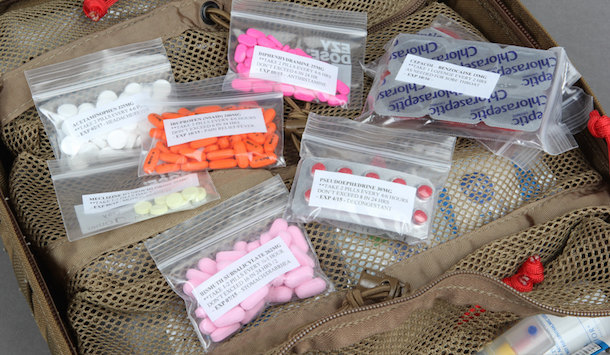For years now, I’ve been repackaging my own over the counter medications for my aid bags and first aid kits. I find that for ease of use and spacial considerations, it’s the way to go.
Who wants to lug around multiple packages or bottles of medications? The only reasons I see to keep the packages would be for dosage information, expiration dates and general knowledge about the product.
Today, I’ll show you how you can still retain all that data and repackage your meds into a few small resealable bags. I’ll also go over the meds I typically carry in my larger aid bag that goes with me almost everywhere.
They’re not only small and work perfect for repackaging, but are made with a thick plastic that holds up well to repeated opening and abuse.
Note: this method is for OTC meds only. Prescription medication (i.e. controlled substances) are best kept as they come with any supporting documentation. Most states require you by law to have a prescription when carrying prescribed medications.
A few years back, I came upon the EZY Dose Pill Pouches, which are 3” wide x 2” tall resealable bags that come in a pack of 100. What I like about them is that they’re not only small and work perfect for repackaging, but are made with a thick plastic that holds up well to repeated opening and abuse.
They’re also great for backpacking toothpaste dots, items in a Dopp Kit and other ways to save weight by repackaging items. They’re available on Amazon for around $6 too, which makes them about 6 cents a piece.
Labeling
With all my meds, I like referring to them by their Generic Name, which is kind of a misnomer. Most people typically think of generics as whatever Wal-Mart or another retailer calls the “generic” version of Advil, when in reality, the generic name is Ibuprofen. I’m not saying all retailers have their own naming convention, but some do and it can be confusing.
My purpose of referring to meds by their Generic Name, rather than their Trade Name (Advil) is so it not only helps me learn the generic names, but also ensures I can substitute “generic” versions of those meds in without having to change naming conventions.
For instance, if Advil was cheaper than Motrin when it came time to replace my expired Ibuprofen, I’d then have to change the name on my labels. Causing more confusion.
With that out of the way, let’s talk labels. I’ve been using a simple Microsoft Word document to manage my labels for some time now and it works out well for me. My document has some basic information for each of the 7 OTC meds I carry and is something I just print out and cut into strips which get inserted into each EZY Dose Bag.
Contained on each label is the generic name, milligram amount, dosage instructions, expiration date and general usage notes for each of the meds I carry in my Aid Bag, below I get into what I mean by “Aid Bag” too.
As my meds are up for expiration, all I do is open the document I’ve created, change the date, print out a new sheet and cut a new strip to insert into the medication I’m replacing. Something I should mention from earlier is that when I do change the brand of medication I double check to ensure the dosage information doesn’t need to be updated as well.
What Meds to Carry?
As mentioned, I’ve been trying to refer to meds by their generic name rather than the trade name, so what you’ll see listed here are not only the generic name, but to provide some context, I’ve also listed the trade names that I carry.
I’ve mentioned that these meds are all over the counter, but Pseudoephedrine (Sudafed) is controlled now. This means that it’s still over the counter, but now you have to show your ID, can’t purchase too much and consent to allow the government to track how much you’re buying, but I digress. Thanks meth heads!
The meds you’ll see here are what I feel represent a good balance of what can be carried without a prescription to be prepared in order to cover a wide range of symptoms that might arise with you and those around you.
• Pseudoephedrine – Decongestant – Sudafed
• Acetaminophen – Headache / Fever Reducer – Tylenol
• Ibuprofen (NSAID) – Soreness / Inflammation – Motrin IB
• *non steroid anti-inflammatory drug*
• Diphenhydramine – Antihistamine / Allergic Reactions – Benadryl
• Bismuth Subsalicylate – Stomach / Diarrhea / Dehydration Prevention – Pepto Bismol
• Meclizine Hydrochloride – Motion Sickness – Dramamine (Less Drowsy)
• Benzocaine – Sore Throat – Cepacol
My Aid Bag
While I won’t go into everything I keep in it today, as we’re primarily focused on meds, I’ve been using a current generation TSSI M9 Bag and have been pretty happy with how it’s been working out for me. It’s an expensive bag, but packed full of features. You can also typically find them used if you look around.
There’s an upper mesh zippered pocket that I keep all my repackaged meds and smaller bottled items in and the layout and functionality of the bag has been great.
Something I’d like to touch on is consistency. Whatever bag you’re using, be consistent with locations of items, so you either always know what pocket to go to in an emergency, or can describe to someone else where that item is located. That’s also a good argument for labeling those individual compartments.
My Aid Bag sits on a shelf in my garage and is there to grab when I’m heading out. I’ll toss it into my FJ when I’m going on a road trip, camping with my family, or especially anywhere with our Boy Scout Troop. It’s great to have in the same location all the time too, just in case its needed around the house.
While we have a medicine cabinet that contains many of the same things in my Aid Bag, two is one and one is none.


